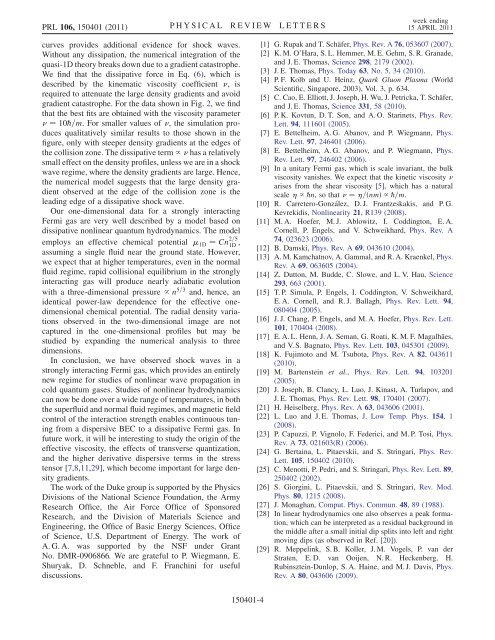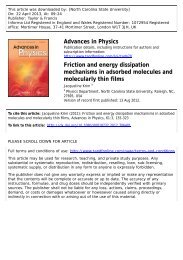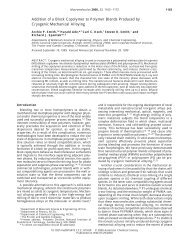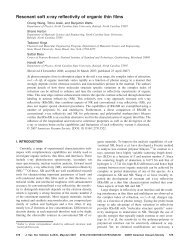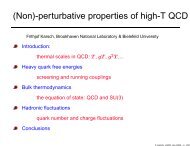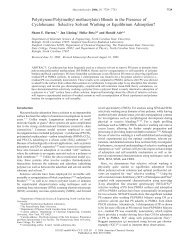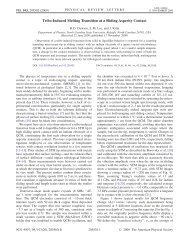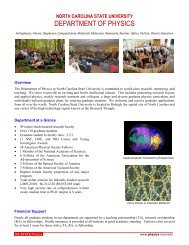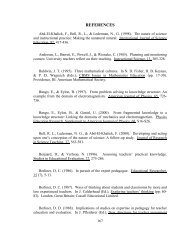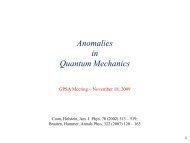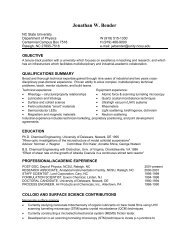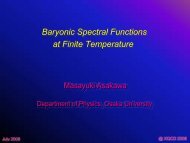Observation of Shock Waves in a Strongly Interacting ... - Physics
Observation of Shock Waves in a Strongly Interacting ... - Physics
Observation of Shock Waves in a Strongly Interacting ... - Physics
You also want an ePaper? Increase the reach of your titles
YUMPU automatically turns print PDFs into web optimized ePapers that Google loves.
PRL 106, 150401 (2011) PHYSICAL REVIEW LETTERSweek end<strong>in</strong>g15 APRIL 2011curves provides additional evidence for shock waves.Without any dissipation, the numerical <strong>in</strong>tegration <strong>of</strong> thequasi-1D theory breaks down due to a gradient catastrophe.We f<strong>in</strong>d that the dissipative force <strong>in</strong> Eq. (6), which isdescribed by the k<strong>in</strong>ematic viscosity coefficient , isrequired to attenuate the large density gradients and avoidgradient catastrophe. For the data shown <strong>in</strong> Fig. 2, we f<strong>in</strong>dthat the best fits are obta<strong>in</strong>ed with the viscosity parameter ¼ 10@=m. For smaller values <strong>of</strong> , the simulation producesqualitatively similar results to those shown <strong>in</strong> thefigure, only with steeper density gradients at the edges <strong>of</strong>the collision zone. The dissipative term / has a relativelysmall effect on the density pr<strong>of</strong>iles, unless we are <strong>in</strong> a shockwave regime, where the density gradients are large. Hence,the numerical model suggests that the large density gradientobserved at the edge <strong>of</strong> the collision zone is thelead<strong>in</strong>g edge <strong>of</strong> a dissipative shock wave.Our one-dimensional data for a strongly <strong>in</strong>teract<strong>in</strong>gFermi gas are very well described by a model based ondissipative nonl<strong>in</strong>ear quantum hydrodynamics. The modelemploys an effective chemical potential 1D ¼ Cn 2=51D ,assum<strong>in</strong>g a s<strong>in</strong>gle fluid near the ground state. However,we expect that at higher temperatures, even <strong>in</strong> the normalfluid regime, rapid collisional equilibrium <strong>in</strong> the strongly<strong>in</strong>teract<strong>in</strong>g gas will produce nearly adiabatic evolutionwith a three-dimensional pressure / n 5=3 and, hence, anidentical power-law dependence for the effective onedimensionalchemical potential. The radial density variationsobserved <strong>in</strong> the two-dimensional image are notcaptured <strong>in</strong> the one-dimensional pr<strong>of</strong>iles but may bestudied by expand<strong>in</strong>g the numerical analysis to threedimensions.In conclusion, we have observed shock waves <strong>in</strong> astrongly <strong>in</strong>teract<strong>in</strong>g Fermi gas, which provides an entirelynew regime for studies <strong>of</strong> nonl<strong>in</strong>ear wave propagation <strong>in</strong>cold quantum gases. Studies <strong>of</strong> nonl<strong>in</strong>ear hydrodynamicscan now be done over a wide range <strong>of</strong> temperatures, <strong>in</strong> boththe superfluid and normal fluid regimes, and magnetic fieldcontrol <strong>of</strong> the <strong>in</strong>teraction strength enables cont<strong>in</strong>uous tun<strong>in</strong>gfrom a dispersive BEC to a dissipative Fermi gas. Infuture work, it will be <strong>in</strong>terest<strong>in</strong>g to study the orig<strong>in</strong> <strong>of</strong> theeffective viscosity, the effects <strong>of</strong> transverse quantization,and the higher derivative dispersive terms <strong>in</strong> the stresstensor [7,8,11,29], which become important for large densitygradients.The work <strong>of</strong> the Duke group is supported by the <strong>Physics</strong>Divisions <strong>of</strong> the National Science Foundation, the ArmyResearch Office, the Air Force Office <strong>of</strong> SponsoredResearch, and the Division <strong>of</strong> Materials Science andEng<strong>in</strong>eer<strong>in</strong>g, the Office <strong>of</strong> Basic Energy Sciences, Office<strong>of</strong> Science, U.S. Department <strong>of</strong> Energy. The work <strong>of</strong>A. G. A. was supported by the NSF under GrantNo. DMR-0906866. We are grateful to P. Wiegmann, E.Shuryak, D. Schneble, and F. Franch<strong>in</strong>i for usefuldiscussions.[1] G. Rupak and T. Schäfer, Phys. Rev. A 76, 053607 (2007).[2] K. M. O’Hara, S. L. Hemmer, M. E. Gehm, S. R. Granade,and J. E. Thomas, Science 298, 2179 (2002).[3] J. E. Thomas, Phys. Today 63, No. 5, 34 (2010).[4] P. F. Kolb and U. He<strong>in</strong>z, Quark Gluon Plasma (WorldScientific, S<strong>in</strong>gapore, 2003), Vol. 3, p. 634.[5] C. Cao, E. Elliott, J. Joseph, H. Wu, J. Petricka, T. Schäfer,and J. E. Thomas, Science 331, 58 (2010).[6] P. K. Kovtun, D. T. Son, and A. O. Star<strong>in</strong>ets, Phys. Rev.Lett. 94, 111601 (2005).[7] E. Bettelheim, A. G. Abanov, and P. Wiegmann, Phys.Rev. Lett. 97, 246401 (2006).[8] E. Bettelheim, A. G. Abanov, and P. Wiegmann, Phys.Rev. Lett. 97, 246402 (2006).[9] In a unitary Fermi gas, which is scale <strong>in</strong>variant, the bulkviscosity vanishes. We expect that the k<strong>in</strong>etic viscosity arises from the shear viscosity [5], which has a naturalscale / @n, so that ¼ =ðnmÞ /@=m.[10] R. Carretero-González, D. J. Frantzeskakis, and P. G.Kevrekidis, Nonl<strong>in</strong>earity 21, R139 (2008).[11] M. A. Hoefer, M. J. Ablowitz, I. Codd<strong>in</strong>gton, E. A.Cornell, P. Engels, and V. Schweikhard, Phys. Rev. A74, 023623 (2006).[12] B. Damski, Phys. Rev. A 69, 043610 (2004).[13] A. M. Kamchatnov, A. Gammal, and R. A. Kraenkel, Phys.Rev. A 69, 063605 (2004).[14] Z. Dutton, M. Budde, C. Slowe, and L. V. Hau, Science293, 663 (2001).[15] T. P. Simula, P. Engels, I. Codd<strong>in</strong>gton, V. Schweikhard,E. A. Cornell, and R. J. Ballagh, Phys. Rev. Lett. 94,080404 (2005).[16] J. J. Chang, P. Engels, and M. A. Hoefer, Phys. Rev. Lett.101, 170404 (2008).[17] E. A. L. Henn, J. A. Seman, G. Roati, K. M. F. Magalhães,and V. S. Bagnato, Phys. Rev. Lett. 103, 045301 (2009).[18] K. Fujimoto and M. Tsubota, Phys. Rev. A 82, 043611(2010).[19] M. Bartenste<strong>in</strong> et al., Phys. Rev. Lett. 94, 103201(2005).[20] J. Joseph, B. Clancy, L. Luo, J. K<strong>in</strong>ast, A. Turlapov, andJ. E. Thomas, Phys. Rev. Lett. 98, 170401 (2007).[21] H. Heiselberg, Phys. Rev. A 63, 043606 (2001).[22] L. Luo and J. E. Thomas, J. Low Temp. Phys. 154, 1(2008).[23] P. Capuzzi, P. Vignolo, F. Federici, and M. P. Tosi, Phys.Rev. A 73, 021603(R) (2006).[24] G. Berta<strong>in</strong>a, L. Pitaevskii, and S. Str<strong>in</strong>gari, Phys. Rev.Lett. 105, 150402 (2010).[25] C. Menotti, P. Pedri, and S. Str<strong>in</strong>gari, Phys. Rev. Lett. 89,250402 (2002).[26] S. Giorg<strong>in</strong>i, L. Pitaevskii, and S. Str<strong>in</strong>gari, Rev. Mod.Phys. 80, 1215 (2008).[27] J. Monaghan, Comput. Phys. Commun. 48, 89 (1988).[28] In l<strong>in</strong>ear hydrodynamics one also observes a peak formation,which can be <strong>in</strong>terpreted as a residual background <strong>in</strong>the middle after a small <strong>in</strong>itial dip splits <strong>in</strong>to left and rightmov<strong>in</strong>g dips (as observed <strong>in</strong> Ref. [20]).[29] R. Meppel<strong>in</strong>k, S. B. Koller, J. M. Vogels, P. van derStraten, E. D. van Ooijen, N. R. Heckenberg, H.Rub<strong>in</strong>szte<strong>in</strong>-Dunlop, S. A. Ha<strong>in</strong>e, and M. J. Davis, Phys.Rev. A 80, 043606 (2009).150401-4


